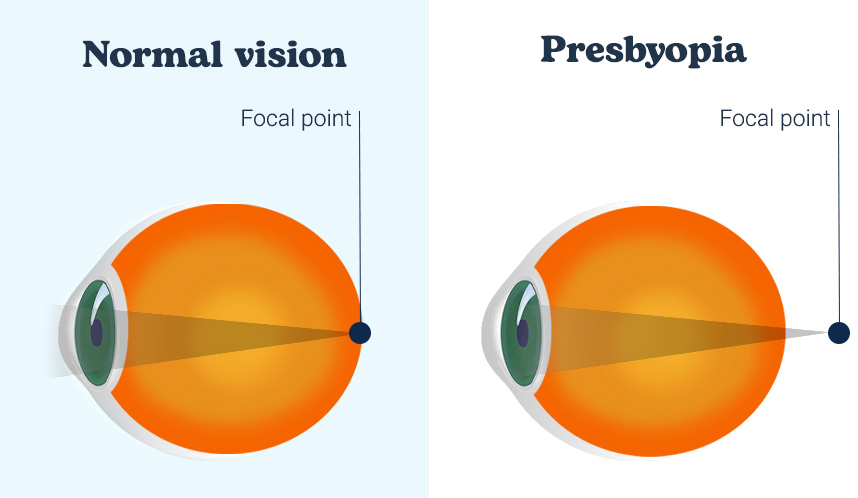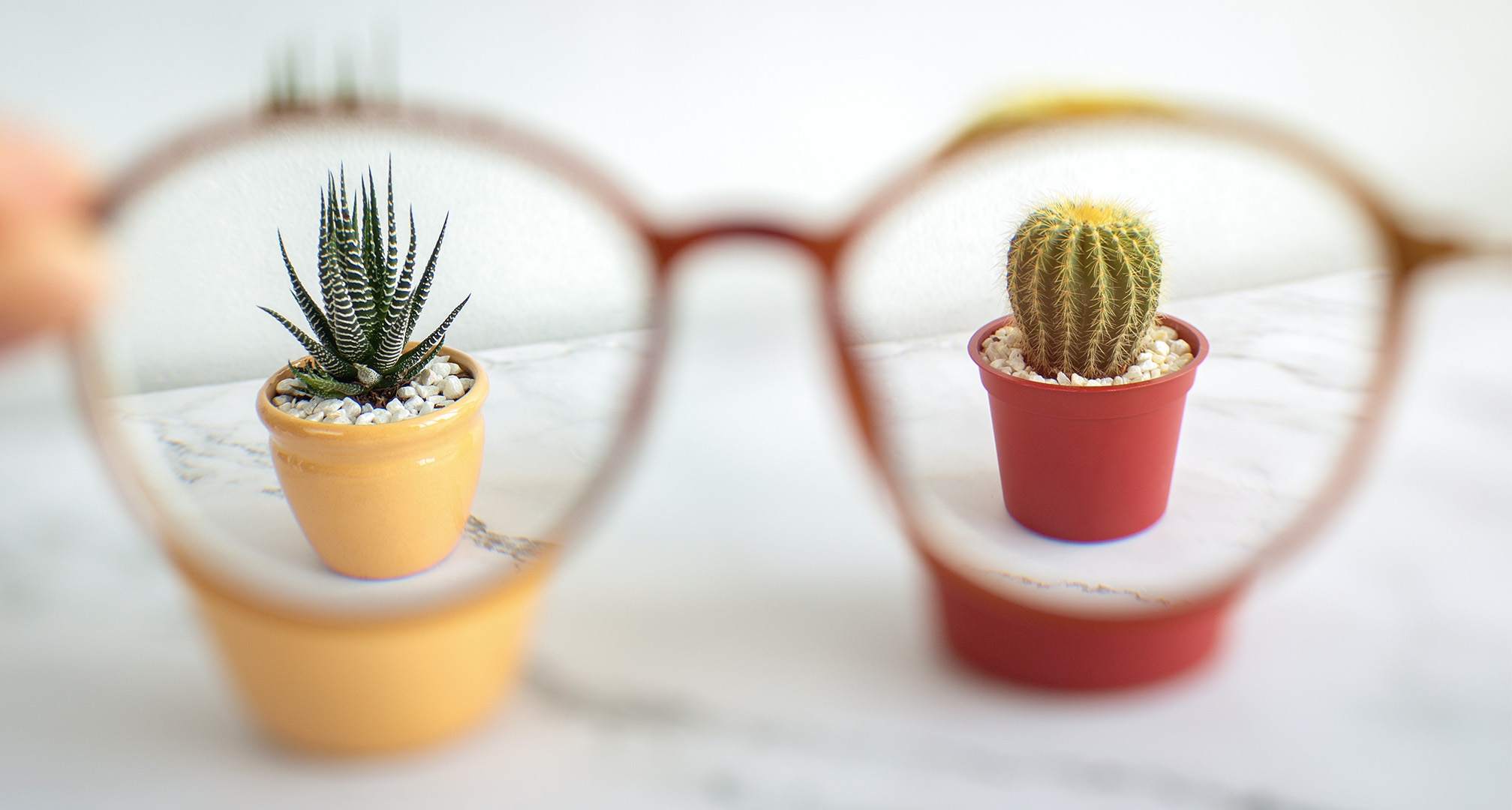What is presbyopia: Causes, treatment & prevention

Table of contents
Picture this: you're sitting in your favourite cosy armchair, engrossed in a thrilling novel, when suddenly, the words on the page become a blurry mess. Frustrating, isn't it? Welcome to the world of presbyopia, where our eyes play tricks on us as we gracefully grow older.
What is presbyopia?
Presbyopia is a condition that affects our eyes as we age. It gradually diminishes our ability to see objects up close, making tasks like reading or using our phones more challenging. In general, this concerns images that are approximately 30 cm away, or further than 30 cm for elderly people.
The natural process of blurring near vision typically becomes noticeable in our early to mid-40s and continues to worsen until around age 65. Around this age, presbyopia generally stabilises itself and does not deteriorate further.
What causes presbyopia?
The main cause behind the onset of presbyopia is the loss of elasticity in our eyes, making it harder to focus on nearby objects. Specifically, it occurs when the central portion of the crystalline lens of the eye hardens due to the physiological decrease of water in the body that is typical of ageing.
This hardening reduces the lens' flexibility, making it unable to change its shape in order to focus on close-up objects. Consequently, with the accommodative capacity of the eye thus reduced, the images appear blurry.

Presbyopia vs myopia, vs hyperopia
Presbyopia, myopia, and hyperopia are three distinct vision impairments that can cause difficulties in seeing objects clearly. While presbyopia typically occurs as we reach our 40s, far-sightedness (hyperopia) and near-sightedness (myopia) can affect us at any age, sometimes even since birth. Presbyopia is not a so-called refractive error like astigmatism, myopia, and hyperopia.
It is rather easy to distinguish myopia and presbyopia, since the former mainly concerns distance vision while the latter concerns near vision. On the other hand, hyperopia impacts our ability to see objects clearly at a near distance as well, and therefore people sometimes get confused between the two. Far-sightedness impairs good visual function at multiple distances but allows fairly good distance vision, while presbyopia progressively impairs only near vision.
It’s also possible to be simultaneously myopic and presbyopic or hypermetropic and presbyopic, but you can’t have myopia and hyperopia together (at least, not in the same eye).
Risk factors
Since presbyopia is a physiological condition, it is very likely to affect us regardless of our lifestyle. However, factors such as genetic predisposition and habits can cause it to occur earlier rather than later, or in more substantial forms.
Here is a list of the factors that can contribute to its onset or speed up its arrival.
- Ageing
- Medical conditions such as diabetes, multiple sclerosis, cardiovascular diseases, autoimmune diseases
- High blood pressure
- Severe eye strain
- Antidepressants, antihistamines, corticosteroids, diuretics
- Abuse of alcohol
Symptoms of presbyopia
- Difficulty reading small characters, sewing, and other close-up activities
- Double vision while reading
- Need to squint to see better
- Need to hold the object you are trying to focus on farther away
- Dizziness and fatigue after reading
- Discomfort or pain in the eye
- Headache and neck pain
- Eye strain
- Need of brighter lighting
How is presbyopia diagnosed?
Presbyopia is diagnosed during a comprehensive eye examination conducted by an eye care professional. This examination involves various tests and procedures to assess your vision and overall eye health.
During the examination, the specialist will likely ask you about any symptoms you may be experiencing, such as difficulty reading small print or eye strain. They will also inquire about your medical history and will perform a visual acuity test to measure your ability to see clearly at different distances. This test typically involves reading letters or numbers from a chart placed at a specific distance.
Other tests your eye care professional may perform are:
- A refraction test, which involves looking through different lenses to determine the exact prescription that provides you with the clearest vision.
- A slit-lamp examination to examine the structures of your eyes in detail. This examination involves using a special microscope-like instrument that provides a magnified view of your eyes.
- A dilated eye exam, using special eye drops that dilate your pupil in order to get a better view of the internal structures of your eyes. This allows them to check for any signs of eye diseases or conditions, such as glaucoma, that may be contributing to your presbyopia.
Our very first recommendation is to take an eye test as soon as you start experiencing changes in your vision. It is important to seek professional advice from an eye care specialist to determine the best course of action and find suitable solutions to address these vision challenges.
How can presbyopia be corrected or treated?
There are several options available to help you see clearly and comfortably, even with presbyopia. From stylish reading glasses to innovative contact lenses to surgery, the world of vision correction has evolved to cater to our needs and offer several treatments for presbyopia.
The expert's advice: If you find yourself constantly putting on and taking off your glasses throughout the day due to the issue of blurry vision at different distances, don't hesitate to visit an eye care specialist to discuss the possibility of multifocal glasses or contact lenses. They can be a stylish choice that keeps you looking youthful.
Glasses
Prescription glasses for near vision, bifocal or multifocal glasses are still the most typical visual aid chosen by those affected by presbyopia. These glasses are specifically crafted to enhance near vision, allowing people to comfortably engage in activities such as reading, writing, and using digital devices. They are tailored to the wearer’s prescription to provide optimal clarity and focus, ensuring a seamless visual experience.

Ready-to-wear reading glasses are also available. They are usually manufactured with +1.00 diopter correction suitable for mild disturbances, a +2.00 diopter correction appropriate for mature individuals, and a +3.00 diopter correction recommended for those in an advanced presbyopic stage.
Contact lenses
Contact lenses specifically designed for presbyopia are now available in many materials and replacement schedules. Multifocal lenses provide a convenient and effective solution, allowing clear vision at various distances. Thanks to advanced technology and precise design, these contact lenses offer optimal visual acuity and comfort and thus provide a practical alternative to traditional eyeglasses.
Surgery
There are two main types of surgery to counteract presbyopia:
Laser refractive surgery, such as PRK (Photorefractive Keratectomy) or LASIK (laser in-situ keratomileusis), has been widely utilised for the correction of refractive defects by altering the curvature of the cornea through the removal of tissue fragments.
Intraocular surgery involves the implantation of a permanent artificial lens, specifically a multifocal accommodative lens. The recovery period following these procedures can vary from person to person, and the suitability of the treatments will depend on factors such as the patient's age and their refractive history.
Looking for multifocal contact lenses?
Look no further! Dozens of state-of-the-art models are available at Lentiamo!
How to slow down presbyopia
It is important to note that it is not really possible to prevent presbyopia, as it is something natural that occurs with ageing. However, it can be slowed down through the adoption of certain beneficial habits that promote eye health.
Exercise
Maintaining a healthy lifestyle that includes regular physical activity, consuming essential vitamins, and refraining from drug, smoking, and alcohol abuse can contribute to overall eye health. Exercising promotes vascularisation and oxygenation of the body.
Wear sunglasses
Protecting the eyes from harmful UV rays is crucial. Wearing sunglasses that provide adequate UV protection can help prevent damage to the eyes.
Regular eye examinations
It is essential to schedule routine eye check-ups to monitor any changes in vision and detect potential issues early on. People with chronic conditions that may impact vision, such as diabetes or hypertension, should also closely manage their health to minimise the risk of visual problems.
Healthy diet
Vitamins A, C, D, and E support eye health. Vitamin A is beneficial for the cornea and retina. Vitamin C reduces the risk of cataract and slows the progression of age-related macular degeneration as well as vitamin E. Vitamin D reduces the risk of macular degeneration, cataracts, and glaucoma and also improves tear function. Additionally, there are other supplements such as magnesium and zinc that act as a protective shield, guarding the eyes against potential vision issues.
In other words: a diet rich in fish, fruit, vegetables and plenty of water.
By incorporating these habits into our daily routine, we can promote the well-being of their eyes and potentially delay the onset of presbyopia.
Closing thoughts from Lentiamo
Presbyopia may be an annoying visual impairment that affects us in our everyday activities, but it's also a reminder of the incredible journey our eyes have been on, and how much they are still capable of showing us. Thanks to modern eye care, it is also fairly simple to manage presbyopia, see better, and feel better. So, let's cherish our eyes, don’t forget to schedule regular eye exams and gracefully meet the challenges of ageing.
Sources:
1.Progress in Retinal and Eye Research, Presbyopia: Effectiveness of correction strategies
2.Ophthalmic & Physiological Optics, Developments in the correction of presbyopia I: spectacle and contact lenses







